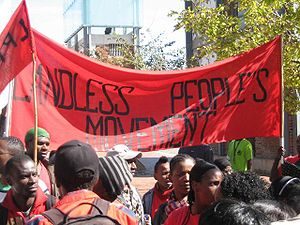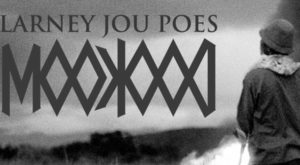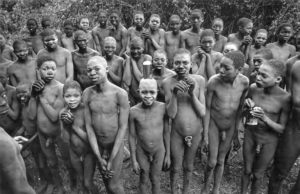
A little reminiscent of the early 1990s Steve Hilton-Barber controversy following the white photographer’s unseemly pictures of naked Sotho initiates (largely an inaccessible site) aroused unflinching backlash from black theatre audiences. Hilton-Barber’s pictures not only instantiated a debased pornotropic and ethnographic palate prevalent in colonial photographic practice but, rather less memorable than the representativity of the disrobed native body, was the fact that Hilton-Barber’s access to the “sacred” site and exposed body of initiates was precisely due to the fact that his family owned those rolling mountains where black rituals were actualized.
Athi Mongezeleli on land politics in South Africa
The Landless People’s Movement outside the Constitutional Court, 14 May 2009 (photographer unknown)
Steve Hilton-Barber’s photos of naked Sotho initiates
What Does Land Mean for South African’s Culture? (Part 1)
This piece serves as a long preamble to a commentary on how the quagmire of land expropriation without compensation, (along with the accompanying land occupations) impact cultural practice writ large. Since 1994 only a small fraction of land has been returned to blacks whilst at the same time, millions of black have been evicted from the places they occupy over the last two decades. Although occupations aren’t a new phenomenon, nor are they always necessarily progressive, the prominence of the land question in public discourse today has, arguably, forced us to pay closer and more critical attention to them. Previously, occupations involved landless blacks “illegally” settling, relatively, within the geographic limits of the townships, or the distant fridges of white suburbia. Although these occupations were always met by the wrath of the state, like the single issue politics of service delivery protests, they also often lacked a far-reaching impact. That is to say, they never affected the colonial settler proprietor, thusly, making them agreeable civil projects for white liberals and leftists alike.
That today there’s a compulsion to pay lip-service to “expropriation of land without compensation,” isn’t necessarily bad. If anything, it alerts us to a reluctant desire for radical change, and the centrality of land (not some or unused land, but all land) in restorative justice. This rhetoric has infused itself so deep in our everyday speech in ways that exceed even political speeches. It has become a rhetoric of our daily talks, memes, and visual forms. Culture, a term arguably difficult to explain today, has found itself at a crossroads now. This is simply because the cultural domain — conceived as intellectual and creative sectors — has, since 1994, openly cheerlead an anti-politics moralist agenda. Its inward-looking approach often meant either an illusory distance from the “administration” or an articulation from within moralist limits of the status quo. Up until recently, the living legacy of colonial conquest has remained totally out of the cultural critical bounds, and when it does emerge, we’d hear, read, or see it presented as a thing of the past/overcome, or as a genre piece with no contemporary resonance. In art historical writings for example, landscape painting remains treated as an index of past transgressions, a series of spatial depictions of extractive economies existing today as alibis of the yesteryears.

Thus when the video Larney Jou Poes (fuck off white man) by the rap outfit Dookoom first appeared in 2014, its narrative arc broke out of this taciturn speech acts post-1994 cultural logic. The black and white video depicted a group farm laborers in a state of riot, threatening to burn the farm. Although its parochial use of insensitive gender stereotypes — “poes” (vagina) — left much to be desired for many, its general substance was not lost. Imagining a group of farm laborers cowered by slave wages and treatment on white owned farms and in white owned homes, coming out and collectively saying “jou poes, my larney” could have not been an easy dream. A year later students called out for Cecil Rhodes’ symbolic head.
The naturalization of settler colonialism by law and culture has not only jaundiced our imagination, it has also debased the very political grammar of black suffering. But what happens when the black public perception begins to see through aporias and promises of our avowed change? What can we say about the pervading rage that we see and hear haunting the landscape in ways largely unprecedented and seemingly antagonistic to the very principles fundamental to that polity?

I will begin this brief meditation by citing the young Nelson Mandela’s reminiscence as captured in his Long Walk to Freedom, during his circumcision graduation ceremony:
“The main speaker of the day was Chief Meligqili, the son of Dalindyebo, and after listening to him, my gaily colored dreams suddenly darkened. He began conventionally, remarking on how fine it was that we were continuing a tradition that had been going on for as long as anyone could remember. Then he turned to us and his tone suddenly changed. “There sit our sons,” he said, “young, healthy, and handsome, the flower of the Xhosa tribe, and the pride of our nation. We have just circumcised them in a ritual that promises them manhood, but I am here to tell you that it is an empty, illusory promise, a promise than can never be fulfilled. For we Xhosas, and all black South Africans, are a conquered people. We are slaves in our own country. We are tenants on our own soil. We have no strength, no power, and no control over our own destiny in the land of our birth. They will go to cities where they will live in shacks and drink cheap alcohol all because we have no land to give them where they could prosper and multiply. They will cough their lungs out deep in the bowels of the white man’s mines, destroying their health, never seeing the sun, so that the white man can live a life of unequaled prosperity. Among these young men are chiefs who will never rule because we have no power to govern ourselves; soldiers who will never fight for we have no weapons to fight with; scholars who will never teach because we have no place for them to study. The abilities, the intelligence, the promise of these young men will be squandered in their attempt to eke out a living doing the simplest, most mindless chores for the white man. These gifts today are naught, for we cannot give them the greatest gift of all, which is freedom and independence. I well know that Qamata is all-seeing and never sleeps, but I have a suspicion that Qamata may in fact be dozing. If this is the case, the sooner I die the better because then I can meet him and shake him awake and tell him that the children of Ngubengcuka, the flower of the Xhosa nation, are dying.”’
That these words represent the anachronistic ghostly remains of a young Mandela (whose older self would come to be infamously considered the black Santa Clause of white supremacist consolidation in post-1994 South Africa) must be terribly disorganizing to most but nevertheless, they remain very poignant. Citation of these words here is neither an attempt to recuperate a different Tata nor is it a resounding call to “return” us to some idealized past. It is, instead, meant to be a detour: one that is often missed in the fervent anti-Mandela bashing and voguish lampooning that inadvertently ends up absolving whites of their culpability.


The expression “we are tenants in our soil” said around Hertzog Bills (1935) echoes Sol Plaatje’s response to the Native Land Act (1913) where he said “the South African native found himself, not actually a slave, but a pariah in the land of his birth”. Being a pariah and/or tenant exemplifies a subject dispossessed of being and land — politically estranged, and culturally dislocated. Though it might sound counterintuitive to underscore this point, it is true: “We have no strength, no power, and no control over our own destiny in the land of our birth.” These are the repeated mantras of our current times as black people realize that they have been sold illusions, and that they too are selling each other the same illusions. Though the chief doesn’t alert us to this; there are social ramifications for those who see the illusion for what it is. For example, the reference to “Zimbabwe” as some biblical fall serves the role of not only cementing an objective culture of ignorance but also hinges on a superficial qualification that black South Africans as substantively outside the continental reality. In the end, we must be grateful! This narrative both repeats the archaic notion of illusory exceptionalism, which in the main is greatly responsible for all Afrophobic outbursts. In essence, the politics of contemporary culture are about maintaining this sense of congenital obscurity.
Reverting back to the Mandela citation above briefly, it is important to note that Chief Meligqili tactfully doesn’t resort to sentimentality (banishment or recuperation) towards the ritual, but instead laments its illusory character. Instead of seeing a counter-hegemonic cultural endurance and adaptability, Meligqili seems impervious to this famed posture, and wonders how their continuity actually fortifies the colonial reality. Thus, his intervention, as Mandela reminisces that “these words began to work in me,” aimed at breaking the uninterrupted logics of cultural certainty and project the grim picture of the black condition whose cultural orientation remained fundamentally surrounded, and each induction readied black subjects for capitulation. That this epiphany of youth later became reversed by charlatanism, is a travesty long seen by I.B. Tabata when he urged the young Mandela to “swim against the stream.” Moreover, the fact that the ritual remains a subject of persistent public sensation and obfuscation by criticasters and apologists alike, equally purloins every gesture of radical scrutiny.
Chief Meligqili’s commentary hinges on the very dissonance between dispossession and cultural life because it has the potential to open a generative path for an “undisciplined” black sensibility — if by discipline it is meant a negotiating between death and life, structurally. Landlessness — not simply as “being without land” but a structural condition of perennial foreclosure — is a subhuman existence. It is not only to be without, but to be nothing, less than nothing. This is what Black Consciousness political movement, Black First, Land First (BLF) gestures to when it exclaims, “Land or Death.” Frantz Fanon echoes this when he says, “I came into the world imbued with the will to find a meaning in things, my spirit filled with the desire to attain to the source of the world, and then I found that I was an object in the midst of other objects.” Of course, here Chief Meligqili would use the word, “slaves.” Slaves have no spatial and temporal integrity as their entire lives are dependent on the whims of their masters — the landed gentry. Thus, our cultural sovereignty and practice wallows in the interstices of interdiction and commodification. Consider how under the British colonial rule mine work was a contending “rite of passage” for black males, but within the apartheid regime’s re-tribalizing efforts, these rituals were reorientated to internalize the logics of racial subservience, and embraced “work” as preordained subtext of black “manhood” — a thesis books like Thando Mgqolazana’s A Man Who is Not a Man (2009) uncritically reproduce.


Steve Hilton-Barber, Sotho Initiation Series, 1990
A little reminiscent of the early 1990s’ Steve Hilton-Barber controversy that ensued after the white photographer’s unseemly pictures of naked Sotho initiates (largely an inaccessible site) aroused unflinching backlash from black audiences. Hilton-Barber’s pictures not only instantiated a debased pornotropic and ethnographic palate prevalent in colonial photographic practice but, rather less memorable than the representativity of the disrobed native body, was the fact that Hilton-Barber’s access to the “sacred” site and exposed body of initiates was precisely due to the fact that his family owned those rolling mountains where black rituals were actualized. More insidiously, he also “secured permission” (as one critic preferred to refer to it) of entry and photographing from the school’s principle, whose family lived as indentured labor in those enchanting plains. The question of the land in Hilton-Barber’s work, though invoked, often takes a secondary position to that of the crude representational approach of his pictures, as if to implicitly suggest that a more considered one would have deflated the tempers. What Chief Meligqili’s words suggest when he says “all black South Africans, are a conquered people,” is that dispossession doesn’t only make this possible, but that in the end, bodies of conquered people form part of the extensive inventory and private property of the landed proprietor. It is such that the very “idea of black culture” seems implausible under the dispossessive regimes of anti-black racism. Furthermore, Meligqili also understands that the plantation logic that haunts his South African offspring knows no son, or even daughter, of the African royalty or elite. These identity markers, much like the promises for gendered integrity, are denied from the inception. Or rather, their feasibility has no universal relationality and therefore “can never be fulfilled” the chief says. Amongst the men and women heaving under the gendered labors of white supremacy, “are chiefs who will never rule because we have no power to govern ourselves; soldiers who will never fight for we have no weapons to fight with; scholars who will never teach because we have no place for them to study.”
What sovereign status does black royalty have when his or her cultural will can be revoked on a whim? What is a black scholar when his or her intellectual claims and scholarly texts can never supersede the presuppositions of his or her existential standing? The chief’s words echo the onto-existential reality of our present situation. Land and culture under these esteemed “royal” meditations, pervade each other, not only because of the proprietary absence of these markers of human practice, but because the world, dispossesses blacks of their very right to possess being, therefore the claim to those “things” that inaugurate their cultural dignity and humanity. To project this unflinching reality of the black also asks that we raise questions that don’t always get the applause or social media likes we crave, or even get the kinds of ratification we assume we’ll get when we engage in political activities that stray out of the norm. These are the kinds of cultural politics that the burgeoning interest in land and occupation seem to engineer or at least force us, to calibrate. A political attitude that always steers off the mark or even against the protocols of “the political.” A politics against politics!
